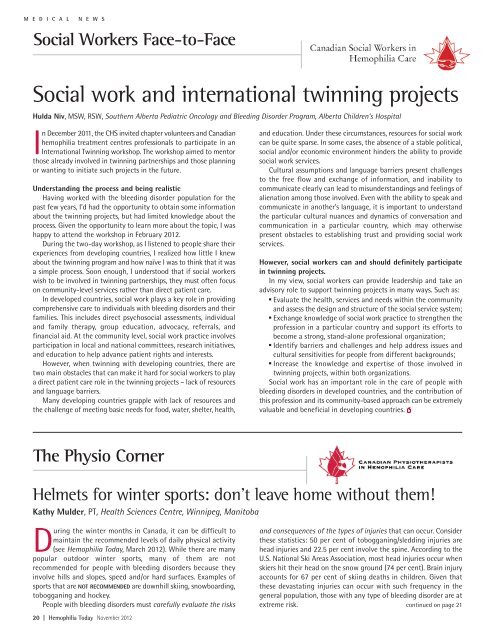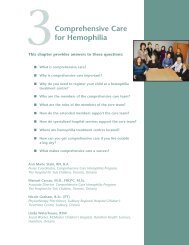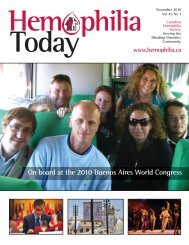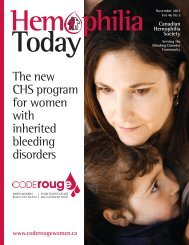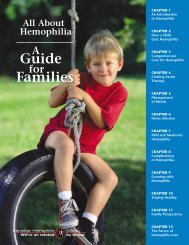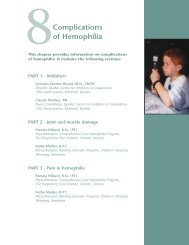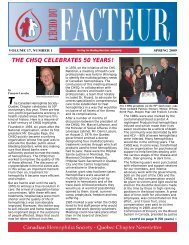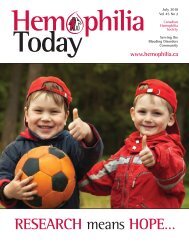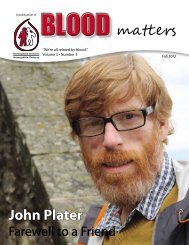Canadian Hemophilia Society
Canadian Hemophilia Society
Canadian Hemophilia Society
You also want an ePaper? Increase the reach of your titles
YUMPU automatically turns print PDFs into web optimized ePapers that Google loves.
M E D I C A L N E W S<br />
Social Workers Face-to-Face<br />
Social work and international twinning projects<br />
Hulda Niv, MSW, RSW, Southern Alberta Pediatric Oncology and Bleeding Disorder Program, Alberta Children’s Hospital<br />
In December 2011, the CHS invited chapter volunteers and <strong>Canadian</strong><br />
hemophilia treatment centres professionals to participate in an<br />
International Twinning workshop. The workshop aimed to mentor<br />
those already involved in twinning partnerships and those planning<br />
or wanting to initiate such projects in the future.<br />
Understanding the process and being realistic<br />
Having worked with the bleeding disorder population for the<br />
past few years, I’d had the opportunity to obtain some information<br />
about the twinning projects, but had limited knowledge about the<br />
process. Given the opportunity to learn more about the topic, I was<br />
happy to attend the workshop in February 2012.<br />
During the two-day workshop, as I listened to people share their<br />
experiences from developing countries, I realized how little I knew<br />
about the twinning program and how naïve I was to think that it was<br />
a simple process. Soon enough, I understood that if social workers<br />
wish to be involved in twinning partnerships, they must often focus<br />
on community-level services rather than direct patient care.<br />
In developed countries, social work plays a key role in providing<br />
comprehensive care to individuals with bleeding disorders and their<br />
families. This includes direct psychosocial assessments, individual<br />
and family therapy, group education, advocacy, referrals, and<br />
financial aid. At the community level, social work practice involves<br />
participation in local and national committees, research initiatives,<br />
and education to help advance patient rights and interests.<br />
However, when twinning with developing countries, there are<br />
two main obstacles that can make it hard for social workers to play<br />
a direct patient care role in the twinning projects – lack of resources<br />
and language barriers.<br />
Many developing countries grapple with lack of resources and<br />
the challenge of meeting basic needs for food, water, shelter, health,<br />
and education. Under these circumstances, resources for social work<br />
can be quite sparse. In some cases, the absence of a stable political,<br />
social and/or economic environment hinders the ability to provide<br />
social work services.<br />
Cultural assumptions and language barriers present challenges<br />
to the free flow and exchange of information, and inability to<br />
communicate clearly can lead to misunderstandings and feelings of<br />
alienation among those involved. Even with the ability to speak and<br />
communicate in another’s language, it is important to understand<br />
the particular cultural nuances and dynamics of conversation and<br />
communication in a particular country, which may otherwise<br />
present obstacles to establishing trust and providing social work<br />
services.<br />
However, social workers can and should definitely participate<br />
in twinning projects.<br />
In my view, social workers can provide leadership and take an<br />
advisory role to support twinning projects in many ways. Such as:<br />
▪ Evaluate the health, services and needs within the community<br />
and assess the design and structure of the social service system;<br />
▪ Exchange knowledge of social work practice to strengthen the<br />
profession in a particular country and support its efforts to<br />
become a strong, stand-alone professional organization;<br />
▪ Identify barriers and challenges and help address issues and<br />
cultural sensitivities for people from different backgrounds;<br />
▪ Increase the knowledge and expertise of those involved in<br />
twinning projects, within both organizations.<br />
Social work has an important role in the care of people with<br />
bleeding disorders in developed countries, and the contribution of<br />
this profession and its community-based approach can be extremely<br />
valuable and beneficial in developing countries.<br />
The Physio Corner<br />
Helmets for winter sports: don’t leave home without them!<br />
Kathy Mulder, PT, Health Sciences Centre, Winnipeg, Manitoba<br />
During the winter months in Canada, it can be difficult to<br />
maintain the recommended levels of daily physical activity<br />
(see <strong>Hemophilia</strong> Today, March 2012). While there are many<br />
popular outdoor winter sports, many of them are not<br />
recommended for people with bleeding disorders because they<br />
involve hills and slopes, speed and/or hard surfaces. Examples of<br />
sports that are NOT RECOMMENDED are downhill skiing, snowboarding,<br />
tobogganing and hockey.<br />
People with bleeding disorders must carefully evaluate the risks<br />
20 | <strong>Hemophilia</strong> Today November 2012<br />
and consequences of the types of injuries that can occur. Consider<br />
these statistics: 50 per cent of tobogganing/sledding injuries are<br />
head injuries and 22.5 per cent involve the spine. According to the<br />
U.S. National Ski Areas Association, most head injuries occur when<br />
skiers hit their head on the snow ground (74 per cent). Brain injury<br />
accounts for 67 per cent of skiing deaths in children. Given that<br />
these devastating injuries can occur with such frequency in the<br />
general population, those with any type of bleeding disorder are at<br />
extreme risk. continued on page 21


